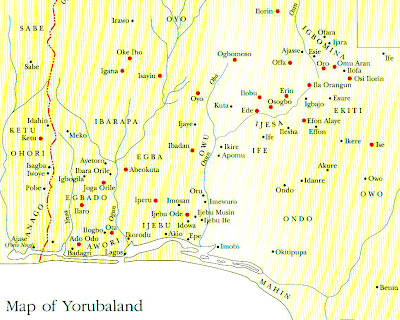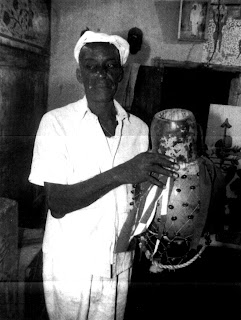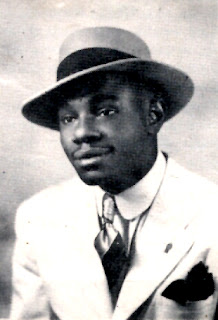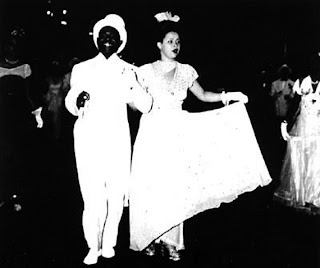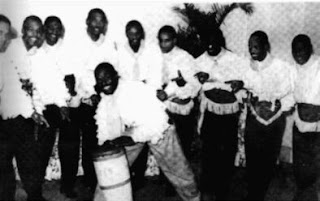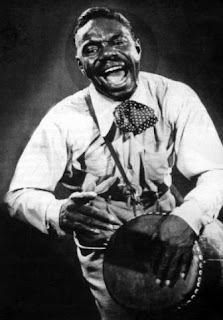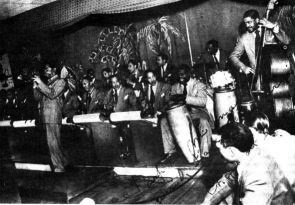 El Goyo with Rumberos de Cuba, January 2004, singing "Mayeya" in duo with Juan de Dios Rámos. (Credit: Rumberos de Cuba Press Kit)
El Goyo with Rumberos de Cuba, January 2004, singing "Mayeya" in duo with Juan de Dios Rámos. (Credit: Rumberos de Cuba Press Kit)Continuing our celebration of El Goyo's 70th birthday last November 17, we publish here an interview by Patrice with the Master himself, conducted during the Stage International course at Tournai, Belgium, in August 2005.
Goyo is the usual professor of afro-cuban dance at this training course. He talks here about the transition of rumba from a purely spontaneous event limited to the "solar" to a more organized presentation, with the appearance of professional groups, real "agrupaciones of rumba", at the beginning of the 1950's. He also explains the importance of the first commercial recording of rumba, in 1956, "El Vive Bien" by Alberto Zayas y su Grupo Foklórico (aka Lulu Yonkori), the success of which he says inspired the creation of other groups such as Los Muñequitos de Matanzas.
PATRICE: So, I would like for you to talk more about the history of the old groups, after Clave and Guaguancó, who were first, you told me.
GOYO: Yes. The first was Clave and Guaguancó. The first one after the coros de clave disappeared.
P: The coros de clave?
G: First were the coros de clave and later the coros de guaguancó: El Paso Franco, Los Rapidos Fiñes, Los Roncos, there were a series of groups, I can't remember them all, because they are stories that aren't... But there were a series of groups, that disappeared around the 1950s.
P: They existed already from the beginning of the 20th century...
G: "Yes. Then, later Clave y Guaguancó was formed. Either later or along with the coros. I don't have this well defined, because the date which they give for the beginning of this group came from the director, Flor de Amor. The current director, Amado Dedeu, asked Flor de Amor, and he replied, "I don't remember well, but I know that it was around World War II." And so from that we figure it to be 1945. Of course the War did not last just one year. So when it was it? The beginning, the end? And so they just say around 1945.
Later in 1953 — and this date is correct — Odilio Urfé formed the Coro Folkórico Cubano. And then later, in 1956...
P: The Coro Folkórico recorded a disc, but later, right?
G: Yes, they recorded a disc called "La rumba y la conga." I have a cassette of that, it explains the rumba and the conga. But they say that was made for the label Gema, a North American company. But it was a Long-Play and was not distributed in Cuba, I think because they weren't confident it would sell.
And so what does Andrés Castillo do? He's head of production at Panart [the first Cuban label]. And that lets him decide what to do. So he decides to do this number, "El vive bien." And that was a huge success. [Senen Suárez attributes responsibility for this recording to Panart owner Ramon Sabát. - Ed.]
So then what happens? It's wasn't like today in Cuba: if you want to promote a song you have to go on the radio, on TV... Back then you had to make little record, and then put it on the juke boxes. You made your own record. You went into the studio and left with your own disc in hand. There are discs that were bad. They are mounted [crossed] in the clave and they stayed like that.
So you got a few friends together, and you bought a little rum and they didn't pay you anything to record. Until recently in Cuba, for the official recordings, you were paid ten pesos per hour. So you wanted to make your record, you got a few friends together and said, "Let's do it!" And so everybody began to make their own little record. And thanks to the juke boxes that record ["El vive bien"] became a hit, a "boom," it was on all the jukeboxes, and then on the radio, on TV. And then you start to get the rise of the other groups, like Los Muñequitos de Matanzas.
P: But in Alberto Zayas' record there are members of the Coro Folklórico, right?
G: Yes, part of that group is on there. It was like a section of that group.
P: Maximino Duquesne was part of the Coro Folklórico...
G: Yes, Maximino is an old rumbero, excellent rumbero. You know they call him "El Moro Quinto." At that time the group was called "Lulu Yonkori." Then later when they made the LP it came out with the name "Coro Folklórico Cubano." So all these groups started forming, and then little by little started disappearing because later they didn't record much. They didn't record anything. The Muñequitos had a time when they disappeared. Yes, you never heard the song that goes, "De nuevo aquí tienen a Los Muñequitos..."?
You see all these groups started dying out around the 1960's. Fariñas (Pedro Celestino) was in the Muñequitos, (and left them) because he earned just 150 pesos a month, and came to live in Havana... How could he stay there? And he had a good spot, he was in the tres-dos. Chacho (Ricardo Llorca), a friend mine who also was in the Muñequitos, he also had leave, he didn't earn enough. And all those groups that came up started disappearing:Los Hijos Buenos, Los Distintos, Los Principales, Los Tercios Modernos, Los Parragueños...they all disappeared.
I was in Los Tercio Modernos, with Juan de Dios [Ramos] "El Colo," Maximino Duquesne, José Antonio, Carlos Quinto and Miguelito [?], who now both live in Chicago, Zorrín, who no longer plays professionally, Pipi who is in the US...the group lasted until about 1961.
P: The Muñequitos had a time when they disappeared...
G: Yes, and they came back with the rumba:
"De nuevo aquí tienen a Los Muñequitos
Ahora sí es verdad que aparacerion, aquí están."
This song is part of that story, there were rumors, people started to talk.
Note: Goyo is referring here to the Muñequitos' song "Oyelos de Nuevo" (Florencio Calle), first recorded in the early '60's (?). The complete lyrics are:
“Un día yo salí de mi casa, de mi casa
Con la mente muy entretenida
Después yo fui sorprendido
con cosas que aquí se dan.
De nuevo aquí tienen a Los Muñequitos.
Ahora sí es verdad que aparecieron
¡Aquí están!
Veni' para que aprecien su valer
No les temen a la calumnia
Ni les sorprenden la injuria, aquí están
Los Muñequitos en la calle, hablen habladores."
"One day I left my house
in a happy state of mind
But I was soon suprised
by everything that goes on around here.
Here they are, the Muñequitos are back!
Now it's really true, they've appeared. Here they are!
Come and appreciate their greatness.
They aren't afried of lies,
Or surprised by the insults.
Here they are!
The Muñequitos are back on the street,
go ahead and gossip all you want."
G: So, Amado [Dedeu] came in as director of Clave y Guaguancó and he changed everything about Clave y Guaguancó. That group was for maintaining the tradition.
P: You mean, of the coros de clave and the coros de guaguancó.
G: Exactly. And they had this style that they didn't have later: they worked with
cajones. That's it. Cajones. Dressed in white, with alpargatas [espadrilles].
G: I have a recording of them from back then at home. They had Agustín Gutiérrez, Miguel
Angel "Aspirina" [Mesa], Chano, the Chano of Malanga.
P: And in Matanzas it happened just like in Havana, Matanzas had its groups too?
G: No, Matanzas did not have groups. The Muñequitos de Matanzas were formed as a result of the success of "Lulu Yonkori," and later Afrocuba de Matanzas. Also Folkloyuma, in Santiago de Cuba.
(Note: Typical year given for the founding of Los Muñequitos de Matanzas is 1952. - Ed.)
P: Folkloyuma is an old group too?
G: Yes. But all these groups came up after Lulu Yonkori. Look, the group that endured, with
difficulties but endured, was Clave y Guaguancó. They designated them as cultural patrimony, same for the Coro Foklórico Cubano. So then they began to get a guaranteed fixed salary.
Odilio Urfé worked with those groups but soon started working in tourist places like the Sans Souci, the Tropicana, he had the power to get into those places. I remember the revue "Van Van Iroko" in the 1956 until 1958 in the Sans Souci. A ton of the best musicians from the street started working in those revues. It was the best work group could get, you had guaranteed pay.
 (L-R:) Ignacio Piñeiro, Marina Sánchez, Estela Rodríguez & Ana María García after a Coro Folklorico Nacional show in the sixties. (Credit: Liner notes, Coro Folklórico Cubano, "...en un solar habanero," EGREM CD 0424)
(L-R:) Ignacio Piñeiro, Marina Sánchez, Estela Rodríguez & Ana María García after a Coro Folklorico Nacional show in the sixties. (Credit: Liner notes, Coro Folklórico Cubano, "...en un solar habanero," EGREM CD 0424)Like Emiliano Sanchez, like...the late Estela Rodríguez, I don't remember all of them, my head is getting old and I forget the names! The Romay Sisters [Mercedes and Juanita], Marina [Sánchez] (1920-2002) played saxophone with Anacaona and left to join the Coro Folkórico. Because Odilio Urfé, Mr. Odilio Urfé always had them working, making money.
P: And the people who became famous in the United States, like Julito Collazo or Mongo Santamaría, they were famous rumberos then?
G: Yes, but those people... look, Cuban folkloric rumba occurred first in the United States than in Cuba. And those people who left for the US, were already well-known timberos here.
P: Mongo recorded one of the first Cuban folkloric discs in the US, which had one rumba. He then recorded a second in 1955, called “Changó” (LP Tico 1149), re-released in 1978 as “Afro-cuban Drums & Chants” (LP Vaya 56), with 4 rumbas. Then in the 1960's he put out a third album, “Bembé” (LP Fantasy 8055), re-released as a compilation (with an album of cha-cha-chá) under the title “Our Man in Havana.” This one has that rumba that goes:
"El agua límpia, límpia, límpia todoDo you know that one?
El agua también límpia la lengua
de la gente"
G: I don't know it. I do know Mongo was very successful there, I met him in 1980, when he came to Cuba. (Listens to a recording of "Para Ti Colega")
P: That is an old number...That is not of the disc "Bembé", but... it must be more recent. I don't know who's on that recording.
G: See? This number is sung with chorus.
P: Hmm?
G: The song is sung as a chorus. Not by a single voice, but a chorus. That's the influence from the first coros de guaguancó.
P: So then after 1960 the groups started to record again. In the 1970s the Muñequitos came back?
G: Well, the Muñequitos... the exact date when they came back I couldn't tell you. But I know that they returned again, the story is this: they say that there was a guy named Lorenzo Martínez [Composer of "Los Beodos." - Ed.] who was the one who moved it, who kept everything, but... Virulilla was was a chapista (metal-worker) [Actually an electrician - Ed.] he went back to working at that... Goyito Seredonio [?] who just died, and Diosdado, who became director. It comes from those times and he was very young when he joined the group and added a pair of dancers. So Odilio Urfé also puts in his group a pair of dancers.
P: And you were telling me that the Muñequitos formed listening to the disc "El vive bien."
G: That's what gave them the idea them to start their own group.
P: Who were the people that formed the first group of the Muñequitos?
G: If you ask me to name each one I don't think I could tell you. They were Ernesto Torriente, Juan Bosco [Mesa], Saldiguera [Esteban Lantrí], Virulilla [Hortensio Alfonso], Goyito Seredonio [Gregorio Díaz], Angel Pelladito, "Chachá" [Esteban Vega]...
P: Florencio Calle?
G: Florencio Calle, the director "Catalino," there were eight of them.
P: Then they began to compose...?
P: Who?
G: Rumba?
P: No, the compositions were made, chico.
P: All of them?
G: All that was done already. The only one that composed rumbas especially for records was Alberto Zayas. But back then it wasn't necessary to write rumbas for your record. In 1950's there wasn't that. Because, in the 1950's in Cuba, there was rumba every day in the street, every day and every week there was rumba. Because the rumba formed spontaneously.
P: There was rumba in lots of places?
G: I mean, spontanteously, without thinking about it: "Hey what's up? Have you heard the new rumba from Tío Tom?" "Which one?" "That one that goes "Los cubanos son rareza..."
Along comes another guy, he takes the clave, boom! boom! Here comes the cajones y se formaba la rumba!
It was like that, because there were places in which every Sunday there was a rumba.
I used to go to Arroyo Nuevo [Municipality about 5kms south from 10 de Octubre and Santos Suárez]. I knew that every Sunday there was a rumba at the Calderon's place. I lived in El Moro, so I would go over to Luyanó, where the Calderones lived. Or if not there, to the solar El Marinero, there were lots of places that had rumba every week.
P: And the famous solar "La Cueva del Humo"?
G: La Cueva del Humo is not a solar. La Cueva del Humo was a marginal district. Like Las Yaguas. It was not a solar. There were three districts in Havana like that. La Cueva del Humo, Las Yaguas and Isla de Pinos. Very poor places... people living with dirt floors, no bathroom, nothing. I have a film at home, "De cierta manera," (dir. Sara Gómez, 1974) [that shows how life was there back then].
That was a saying we had back then. In Cuba always there is a style of greeting, that comes from the people, "¿Qué volá, asere?", "No, aquí, de cierta manera, (in a certain way)". And later, "Give me a drink, no hay má' na´..." ("there's nothing else...").
The popular language of the street is like that. The women, for example. There was this rumba that says:
"Soy cubano y quiero a cuba
y muero por mi bandera
y te canto guaguancó
de la región matancera
La Habana es la cabecera
Como capital bendita
En ella se encuentra todo
Lo que Uds. necesitan
Desde un pollo zalamero
que le alegre el corazón
desde el alto magistrado
que dirige la nación"
Have you heard that one? It says "un pollo zalamero," what does that mean to you?
P: I don't know...
G: A pollo zalamero, that's how they called the women, like "Wow, what an flattering chicken!" "A beautiful woman!" then they said "aleja" then "jeba" and now they say "mango" - "You see that mango over there?" That's the popular slang. Well, the film [De Cierta Manera] goes back to those days. "So, what's up?" "Well, here in a certain way." That's the popular slang. Well, the film I was talking about goes back to those times: "What's up, man?" "Well, I'm here, in a certain way." And that's the name of the film.
But that saying was strong at the time that the Revolution begins to rehabilitate all those marginal districts. And to give houses to people. And to break a little the mentality. That is old. There in that film you are going to see something of Las Yaguas. It has some shots of Las Yaguas, how it was back in those times. Then there were three similar districts: La Cueva del Humo, Las Yaguas and Isla de Pinos, which they said was exactly between the Castiva Factory and Cristina. And Las Yaguas in Luyanó. That's there I lived.
P: Thank you.
G: At your service.






























